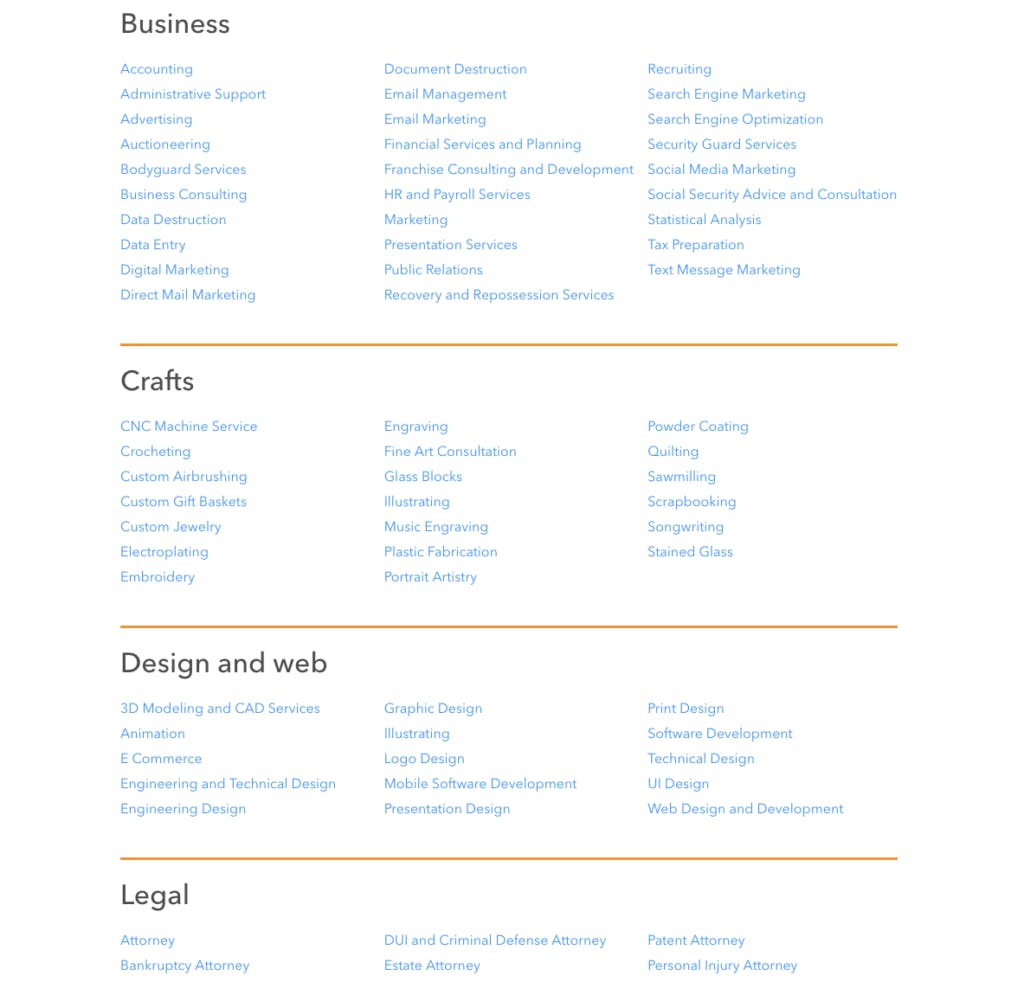Why did Thumbtack succeed?
Starting your marketplace with one city and one vertical is key. But for every rule, there's an exception.
Published on
Last updated on

Thumbtack, a marketplace for local professionals, started out by offering any type of service in all US cities. In this article, we explain why this was a good strategy for them and why most aspiring marketplace entrepreneurs shouldn't try to replicate it.
The most important piece of advice I've ever heard is this: there's no single piece of advice that applies to all businesses. The context—your risk aversion, business goals, and your specific business concept—needs to be kept in mind whenever you hear advice.
In our previous article on the importance of focusing on one city and one vertical, the advice we gave is no exception. A notable counterexample to it is Thumbtack, one of the successful modern marketplaces, with a valuation of over $1 billion and reported revenue of over $100 million.
Thumbtack focuses on helping customers find local professionals. This is how the founder and CEO, Marco Zappacosta, explains how they got started on the company's blog:
– When we launched, we wanted to be the most helpful to the most people. So to do that, we offered every type of local service in every region of the U.S.
They did the exact opposite of what many marketplace experts recommend. Why did this strategy work out for them? To understand that, we need to examine their story more closely.
When Thumbtack was founded in 2009, the competitive landscape was quite different. No mainstream marketplaces provided a solid end-to-end booking experience in any professional services categories. Thumbtack was mostly competing against directory sites like Angie's list and Yelp. There was no need to worry about providing excellent CRM (customer relationship management) tools for their providers—being a better lead magnet than their competitors was enough.
Since they were targeting professionals who already had an online presence with contact details, they were able to scrape the information of all US providers with a web crawler and contact them en masse.

They found a clever way to build supply by creating a single-player mode that worked for every service industry: a tool that allowed the providers to easily post a good-looking listing to Craigslist. Airbnb used the same exact strategy to boost their early growth.
As Zappacosta explains, Thumbtack knew they would not be able to use the most lucrative marketplace business model—the commission model—as there was no way for them to control the transaction process in every single category. Explained in terms of the booking flow matrix, it was not possible for them to build an offering with packaged pricing.
Instead, they opted for a simpler subscription model. This was a great start because it provided them with cash from the very beginning: they were quickly able to find 10,000 providers who were willing to pay to get more online visibility and access to the Craigslist integration. However, the problem with this model was that the fee did not correlate with how much revenue they were bringing in for each provider. Thumbtack switched to a lead fee model, which turned out to be an ideal fit for them.
Nowadays, Thumbtack has the resources to provide an end-to-end experience. As Zappacosta explains in his post:
– The more tools we can provide (payments, scheduling, invoicing, business management, etc.), the faster and easier our customers can get their projects done and the more our pros can focus on what they do best: providing an incredible service.
It's easy to understand why this is vital for Thumbtack. If they don't provide these types of tools for providers, they won't be able to capture providers' recurring transactions. After a customer has found a great provider through the site, the customer could just contact the provider directly, bypassing Thumbtack. If Thumbtack can provide great CRM tools for providers, it might be able to funnel a large part of each provider's invoicing through its platform, increasing its revenue.
However, Thumbtack's biggest problem is not the providers but the customers. Sarah Lacy of Pando explains the downsides of the lead fee model in her excellent analysis of Thumbtack's strategy:
"The biggest risk to the strategy is customers coming once, not getting a bid and never coming back again. As it seeks to build more of a consumer brand this year and bring more pros on the site, this is the single biggest balancing act the company will have to achieve. Zappacosta acknowledges the company doesn't handle this well now.."
Lacy also explains how she tried booking house cleaning through the site. She got exactly one bid. The experience was ok, but she expected more.
Contrast this to Handy's customer experience. You can book a cleaner for a chosen time, choose all the relevant services, and pay online, all in a matter of minutes—no need to wait for bids from providers and worry about not getting any.
With their current model, Thumbtack will never be able to build this kind of end-to-end experience. It's simply not feasible for them to build custom flows for all their hundreds of categories. This is their biggest weakness—customers have grown to expect this type of seamless experience. In 2009, expectations were much lower for professional services, but since 2017, expectations have changed. Many services operate in Thumbtack's key industries like home cleaning, catering, pet sitting, and home tutoring.
A good end-to-end customer experience is important from the provider perspective as well. Lacy goes on to explain:
"Some professional forums complain about the quality of the bids that come from Thumbtack, and that a customer will post a job, they'll bid on it and pay Thumbtack a commission based on that posting, only to have the customer haggle them down on price."
This is another issue that the end-to-end customer experience solves elegantly: as you pay upfront, there's no chance of haggling.
Thumbtack doesn't have anything to worry about for a while. Many of its categories—like plumbers, electricians, and carpenters—might never be suitable for the packaged pricing workflow. They are simply so case-specific that negotiation between the customer and the provider is always needed to determine the pricing. For these industries, Thumbtack is well equipped to solve the challenges mentioned above. However, several professional service industries will likely eventually move away from Thumbtack to vertical-specific marketplaces with great end-to-end customer experiences.
Despite the challenges mentioned above, it might be tempting to follow Thumbtack's strategy when building your own platform. After all, it's a lightweight approach that doesn't require much from your product in the beginning, and Thumbtack has seen incredible success with it. I believe, however, that's a bad idea for several reasons.
First: Thumbtack is a dominant player in the US, and it would be incredibly difficult to compete with them with a similar strategy. It probably doesn't help to focus on one of Thumbtack's verticals and cities and try to make the lead fee model work for only that specific group. This is not enough to give you a competitive advantage without the end-to-end customer experience. In order to work financially, this type of directory site and lead fee business model needs to have a large volume of users. You might have a shot if you're in a country other than the US, but most countries already have similar, relatively established players.
Second: it's 2024, not 2009. It's currently possible to build great end-to-end customer experiences at a lower cost. People have become accustomed to such experiences in the services they use. If you're not able to deliver such a service today, you will have a hard time building your business. I strongly believe that knowing one industry well and offering tailored customer and provider experiences for that specific industry is the key to success when building a modern service marketplace.
In many ways, Thumbtack is an exception that proves the rule. The lesson we can learn by examining their success is that starting from one city and focusing on a single vertical remains the right strategy for almost all new service marketplace businesses.
You might also like...

Marketplace pricing: How to set the right take rate
The right marketplace pricing level depends on many different factors internal or external to your marketplace. Here's what you should consider to find the optimal pricing level for your marketplace.

The concierge marketplace model: how to match supply & demand
Boost your growth by manually matching your marketplace supply and demand. Mike Williams discusses the benefits of the concierge marketplace model.

Josh Breinlinger at the Marketplace Conference: How to maximize liquidity and transaction quality
A long list of actionable tips for marketplace entrepreneurs, courtesy of Josh Breinlinger, Managing Director at Jackson Square Ventures. This is the third article in a series covering our favourite talks from the first Marketplace Conference in San Francisco.
Start your 14-day free trial
Create a marketplace today!
- Launch quickly, without coding
- Extend infinitely
- Scale to any size
No credit card required
